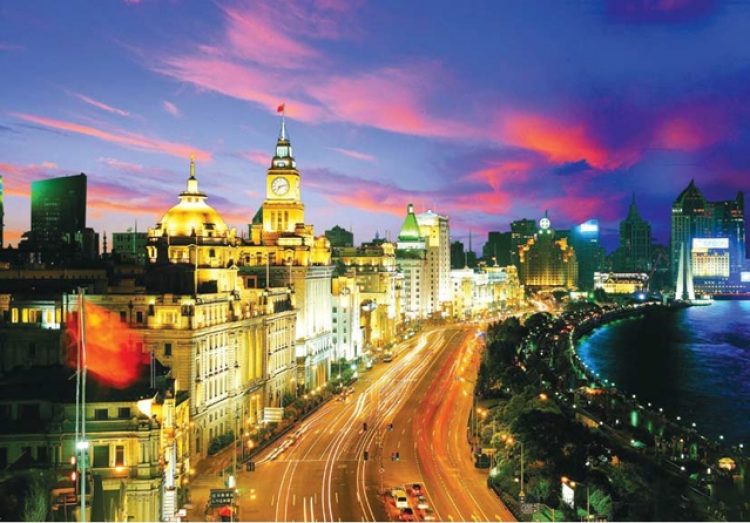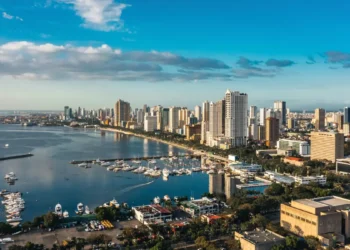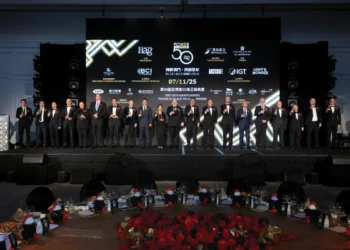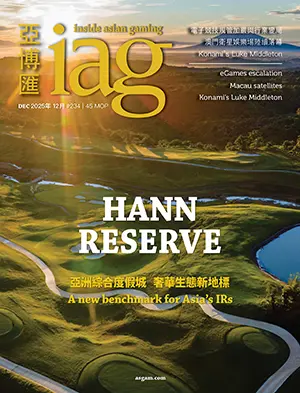The coming proliferation of non-gaming hotels developed by MGM Resorts International in China is a testament to the company’s success in cultivating ‘guanxi’
Fresh off a fourth quarter that saw a 52% increase in net revenue—thanks largely to resurgent room rates on the Las Vegas Strip and stellar performance at its Macau subsidiary—MGM Resorts International is raising its bet on Asia with plans for another luxury non-gaming hotel, its fifth, this one a Bellagio-branded project in Shanghai.
Scheduled to open in 2015, right about the time MGM hopes to have carved a significant slice of Cotai for itself, the 200-room Suning Bellagio Shanghai Bund will put 200 hotel rooms, world-class restaurants and an assortment of high-end amenities in the heart of the city’s historic waterfront district, providing the casino giant with a five-star presence in China’s largest city and another gilt-edged calling card for introducing high-net-worth mainlanders to its VIP rooms at MGM Macau and high-stakes baccarat tables in Vegas.
The Bund, famous in the late 19th and early 20th centuries as a centre of Western commercial activity in the Far East, is enjoying a renaissance as a destination for business and leisure travellers throughout China and abroad, with attractions that include a glittering promenade along the Huangpu River, a tributary of the Yangtze. The financial arrangements that landed this prime real estate for MGM were not disclosed. But the location certainly is a coup for the joint venture the company has formed with the renowned Diaoyutai State Guesthouse to pepper China’s booming hotel market with MGM Grand, Bellagio and MGM Skylofts marquees and a testament to its success in cultivating ‘guanxi,’ a must for success in doing business in China, the term signifying connections with the powers that be—‘juice,’ as they’d call it in Vegas. The Shanghai partner providing the land, Suning Real Estate Group, is an arm of a conglomerate with a sizable share of the country’s massive retail electronics and home appliance markets and global ambitions of its own. Before the decade is out, Suning wants to add to an already hefty portfolio some 100 hotels and 50 mixed-used commercial, industrial and residential projects in first- and second-tier cities nationwide.
As aggressive development strategies go, Suning’s speaks to a vision similar to MGM Resorts’, as CEO Jim Murren noted in a statement when the project was announced: “We believe relationships like this with Suning create new opportunities to expand our brand reach into this strategically vital marketplace.”
Wealthy gamblers are of course an important part of the vision, but Murren & Co. have big eyes for an entire continent of increasingly affluent and mobile travellers. The Asia-Pacific region alone accounted for 22% of global tourism arrivals in 2011, according to the United Nations World Tourism Organization. Their share is expected to grow four to six percentage points this year. Not surprisingly, MGM Hospitality, the company’s hotel development and management subsidiary, is mapping luxury resort projects from Beijing to Marrakech. Its most celebrated to date, MGM Grand Ho Tram, opens in phases beginning next year with the first of two five-star hotel towers (1,100 rooms and suites in all) and, significantly, Vietnam’s first casino. Also slated for a 2013 opening is an MGM Grand, sans gambling, in the Sinai resort of Sharm El-Sheikh. An MGM Grand Cairo, a Bellagio at Dubai Pearl, multibillion-dollar mixeduse development in the UAE, and in Abu Dhabi an MGM Grand with a number of Skylofts penthouse suites are scheduled for completion in 2014. Developments also are under way in India, in Mumbai, New Delhi and Jaipur.
In Diaoyutai MGM has scored a partner without peer among Chinese hoteliers. The landmark State Guesthouse, a complex of lush gardens and luxury villas, was originally assembled in 1958 to accommodate heads of state arriving for celebrations surrounding the 10th anniversary of the Communist revolution. It was so appealing it was appropriated during the Cultural Revolution by Madame Mao as her personal residence and continued to function for nearly a halfcentury before it was opened to the paying public, as a favorite retreat of party hierarchy, provincial big shots and foreign dignitaries.
Synonymous with elegance and worldclass service, the Diaoyutai State Guesthouse strikes just the note of high-toned chic Diaoyutai MGM Hospitality desires to project with resorts like the recently opened MGM Grand Sanya. Located on Hainan Island’s scenic Yalong Bay, Sanya debuted in early February in time for the Spring Festival, when it hosted former Vice Premier Wu Yi. A beachfront getaway designed to fit cosily with the aspirational self-image China’s new rich are busily cultivating, it features 675 rooms, suites and beach villas (the smallest starting at 56 square meters), meeting space, and much of what those who can afford it might expect to find on the Las Vegas Strip: like a poolside day club by Wet Republic and an AOC wine bar, along with the fine-dining restaurants, the nightclub and spa and proximity to several golf courses.
Next up for the joint venture is Diaoyutai Hotel Beijing, Lama Temple, scheduled to open in the third quarter in the Guozijian Cultural Reserve in the heart of the capital with a Tadao Ando architectural scheme blending traditional Siheyuan elements with contemporary styles. It will house 105 rooms and suites, conference and meeting space, an art museum and 12,500 square meters of spa and wellness facilities centered on a natural hot springs.
An MGM Grand with a Skylofts component is under construction and slated to open in 2014 in Chengdu, the capital of Sichuan Province. The city of 7 million, the commercial and manufacturing hub of the southwest, has drawn over the last decade an enormous amount of multinational investment.
The last hotel in the joint venture’s current pipeline is MGM Grand Tianjin and Skylofts at MGM Grand Tianjin. These are located within the new Sinosteel International Plaza, a centerpiece of redevelopment efforts in the northern port city of 10 million and typical of the kind of large-scale projects combining commercial and residential elements that in China tend to enjoy favour with local governments and land lessees and developers. Experts like hospitality consultants Horwath HTL say developers for the most part are more than prepared to risk weak returns on the commercial component for the large profits to be made on residential sales. The hotel piece generally is perceived as crucial to the branding of the overall project, providing valuable name recognition that more than offsets the likelihood of lower returns in markets, and there are several, where average daily room rates are softening as a result of overbuilding. The cachet of a five-star resort is especially prized, which plays to the advantage of Diaoyutai MGM Hospitality, among others. The portion of the Sinosteel complex the joint venture will operate is located in the 88-floor main tower and includes several hundred guest rooms, penthouse-size suites, luxury condominiums and an assortment of dining and leisure attractions.
“The portion of the Sinosteel complex the [Diaoyutai MGM Hospitality] joint venture will operate is located in the 88-floor main tower and includes several hundred guest rooms, penthouse-size suites, luxury condominiums and an assortment of dining and leisure attractions.”
As far as MGM Resorts is concerned, the benefits of a presence in Shanghai have less to do with ADRs and RevPAR than with the sizable opportunities it affords for crossmarketing the casino at MGM Macau—and those of its properties on the Las Vegas Strip, where baccarat play, most of it Chinese, now generates the lion’s share of table game revenues.
MGM China Holdings is the only single-property operator in Macau and the property with the fewest tables, so it’s had to be somewhat creative, maneuvering around the junket networks in some instances to market directly to VIPs and introducing a lounge targeting its more lucrative main floor customers. Since MGM Resorts took over majority control last summer the property performance has steadily improved relative to its modest size. Adjusted property EBITDA was up 23% to US$174 million in the fourth quarter on a 26% increase in net revenue to $719 million, driven by increases across-the-board in VIP and mass-market table play and slots of 29%, 13% and 35%, respectively. For the year, VIP revenue increased almost 80%, mass-market table revenue 32% and slots60.7%. EBITDA soared 74.3% year-on- year on a 64.7% jump in gaming revenue.
An Asia rollout of the parent company’s M Life loyalty rewards is no doubt on the way, and its integration will dovetail nicely with these efforts. Importantly, it will tie them more closely with the luxury hotel expansion on the mainland.
It’s estimated that half of China’s 1.3 billion people will undertake holiday travel in 2012, 90% of them within the country. Pursuing more of them by moving beyond Macau’s dependence on the southeast of the country makes sense. Shanghai, which has emerged as a destination of choice for them, is as good a place as any to start.
For years, the city lagged Hong Kong and Beijing in popularity. But that changed in 2010 when it hosted the World Expo. Tourism revenue jumped 30% that year to 305.5 billion renminbi (US$46.4 billion). Knowing lightning in a bottle when they see it, the municipal government has identified tourism as a priority and has earmarked more than US$6 billion to enhance the city’s appeal. A Disney resort.is coming in 2014. More than 14,000 new hotel rooms are in the pipeline. By the time the Suning Bellagio Shanghai opens in 2015, tourism receipts are expected to hit 520 billion renminbi.








-120x86.jpg)
























